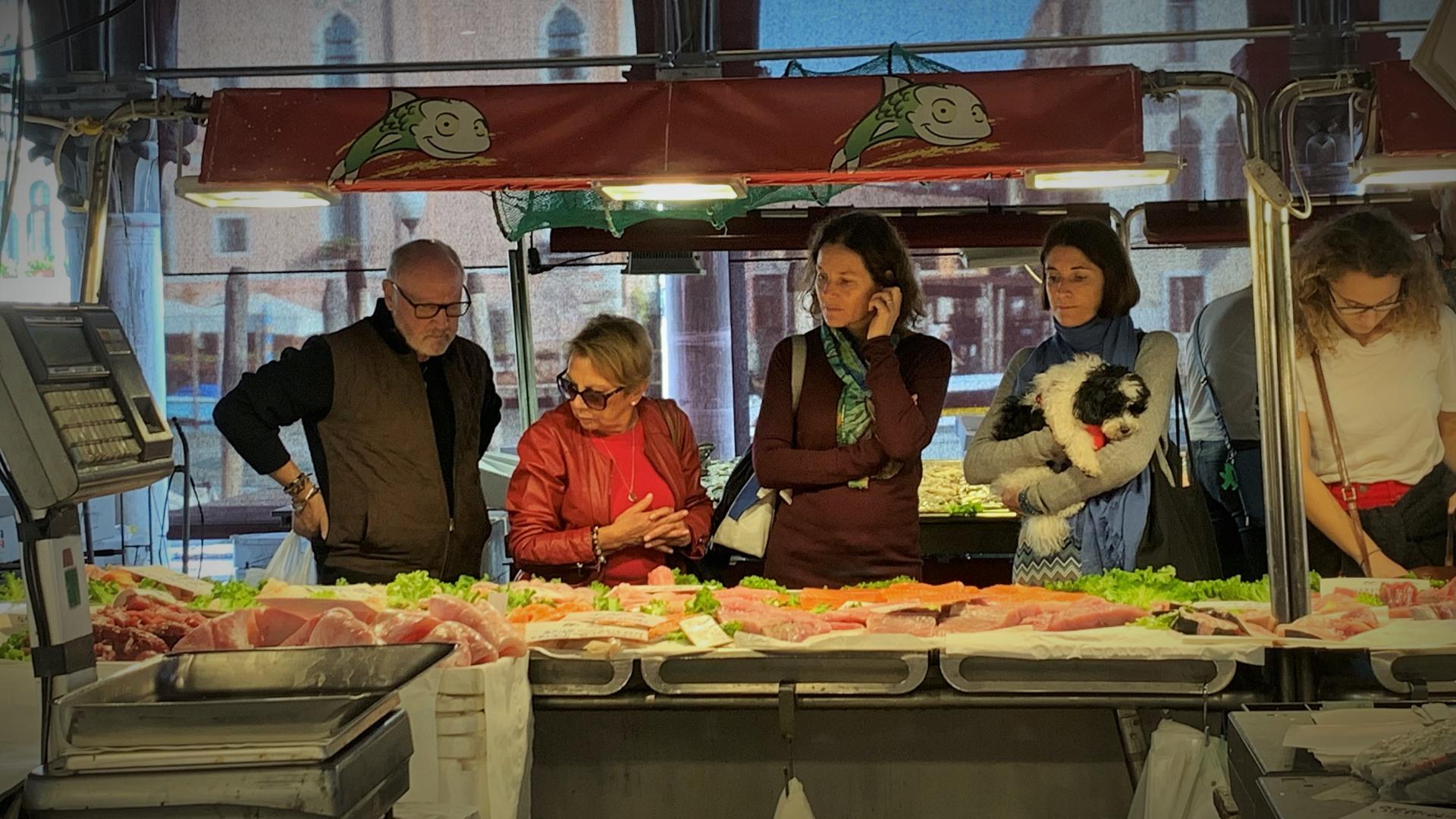Italian food markets are a big attraction for both traveling foodies and locals!
Italians love their food markets coz in the markets you breath that humanity gone lost in supermarkets and shopping malls. Markets are the beating heart of a city food culture. Streaty’s Venice street food tour includes fish market tour and we assure that it is more than a walk, it’s a dive into the roughest Venetian spirit!
However, not all Italians love shopping at food markets…why? Coz it’s not that easy and unhuman as the supermarkets, coz it involves interactions, negotiations and looooooads of patience!
What about foreign foodies? How can they survive an Italian food market experience? Read this out and take notes!
Food market timing
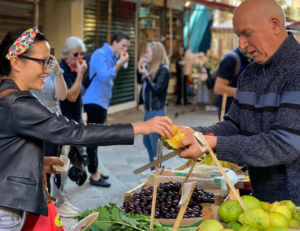
If you need to buy frozen fish and chips, you simply walk to the supermarket, you slide the fridge door and pick it. What if you need to buy fresh fish?
First of all, you need to track back the fishing business. Do fishermen bring fresh fish every morning? Answer, no. Monday morning is the day to avoid shopping fish because Sunday night is time off for fishermen.
Cool, so that means that any other day is good to find the right local fish? Answer, maybe.
Not all fish sold at Italian fish market benches are coming from the local coasts. If you wanna find out what happens behind the curtains, take some sleep left and get in the “mercato ittico” early in the morning (3-4 am) and see what your fish mongers purchase. The Mercato Ittico is the main fish distribution hub of a city. You can freely access.
Timing in the food market also means “season”.
What’s generally the best time to shop?
I’m gonna give you a typical Italian answer: It depends! It depends on what you need to buy. If your wife ordered a Pasta col nero di seppia for dinner, you better head to Rialto Fish Market at opening time (7.30 am) in order to find the right squids and save the ink! If you are simply searching for the deal of the day, then go to your fish monger at closing time, when he needs to get rid of some fish sold for a very convenient price!
Timing is the key, this is why we plan a fish market food tour in our Catania street food tour at a specific time!
How to choose food
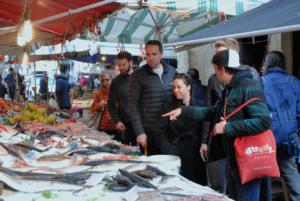
If you don’t have your own vendors, you can use two simple ways for it. If you can’t speak Italian and don’t know how to ask vendors, you could simply google “fruits and vegs season in Italy” to have a better understanding of what you should buy in that specific season. In alternative you can use your eagle eye and focus on the shapes and colors of products. If you see that all lemmons have exactly the same colour and shape, that means they have been selected in an industry or similar with weight machines.
Same story if you see beautiful shiny apples. Those apples went through wax polishing! How disgusting!
The principle is easy, the worse a product looks the better it is. Nature gives birth to products under winds, rains and sunrays! Seasonal local products have a shorter supply chain from the lands to your hands, less treatment and selection processes. There is no reason to import Apples from Australia when Venice markets can get supplied from Trentino’s producers!
Food market pricing
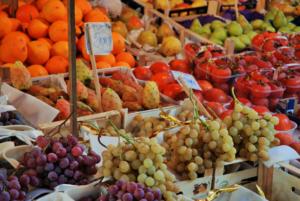
Rule number 1, you will be cheated soon or later and it simply part of the game. You wanna play? Play it with street rules.
There is no algorithm to calculate how much you gonna spend when you enter an Italian food market. In fact, some products are sold for a fixed price per unity, other products are sold per “etto” (100gr), others per Kg.
Exercise! Prices: 1 eggplant 0,50 euro / 1 kg of tomato 1 euro / 1 etto of olives 3 euro. Now, you buy 3 eggplants, 2,5 kg of tomatoes, 3 ettos of olives. How much you pay?Your math says: 1,50 euro eggplant + 2,50 euro tomato + 9 euro olives = 13 euro!
WRONG! If eggplants are in season they are unlikely to have the same size, so one eggplant might be sold for 0,50 but a bigger one for 0,75 cents. Tomatos weight will never come out precise with a precise price. It will be round up! Same will happen for olives. But you might want to have a little bit of green olives and a little bit of black ones which have different prices.
In conclusion, what should you do not to stress out? Simply tell your vendor what you are going to cook, how you will cook it, for how many people and what’s your budget.
However to understand better how pricing works, you better read next chapter.
Food market social life
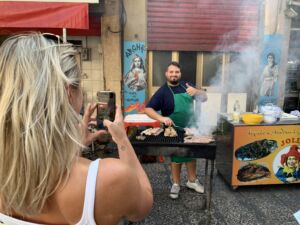
A Palermo local market experience isn’t about shopping. It’s all about socializing.
Your vendor is your priest: you confess your glutton sins and he will absolve them with the right recipe. Your veg vendor can read your mind. You have been shopping at his stall since you were a kid. Your fruit vendor was your Mum’s fruit vendor, and your fruit vendor’s father was serving your grandmothers. Once an American travellers told me “I guess all Italians are related in a way or another”. I never questioned myself about the meaning of it but it keeps spinning in my mind and keeps explaining so many things about being Italian. The relation between vendors and clients is one of those.
What’s the plus of having your own vendors?
You could be the silliest city boy but still do the best quality shopping in the world! Your vendor will tell you what’s in season and what’s not. Not only this, your vendor is very likely to be an expert cook, at least of what he sells! So he will help you choose the right tomato to make sauces or to sundry! One of the highlights of our Florence street food and local market tour is the visit at Sant’Ambrogio market. Travellers love to see how real Florentine market life works, and everything happens the way it is! Unplanned!
Three good reasons to choose the markets instead of supermarkets
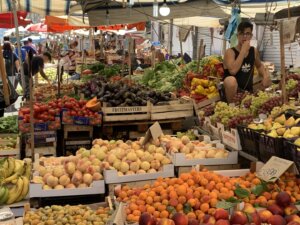
Reason number one, very very easy, at the markets you find fresher foods (mostly local) and for a better price. Reason number two. It’s fun! So fun! The passion you feel in the markets is unique, you breath history, traditions, you smell the blossom of nature (which will train your nose as a wine taster too!), get inspired! Reason number three. You support local businesses. Most of food market vendors are family businesses. By shopping at the markets you help local economy and lenghten local food traditions. We are very proud to have designed the Catania street food tour at the Catania food market La Pescheria including a seasonal treat to be purchased at the moment.
Italian food market: dos and don’ts
We are all tourists once we leave our country, aren’t we? When we travel we have different manners and habits. Our behaviour does have an impact on locals’ life, nothing to feel guilty about! Many of our behaviours bring positive effects to a place, not only in terms of finance but also of cultural exchange.
However, when in Rome…
So, how do we visit Italian food markets in a respectful and sustainable way?
Here is some Dos and Donts:
- Yes, do choose the market to shop fruits instead of big chain supermarkets;
- Avoid picking products from the benches to take a selfie. Vendors go nuts!
- Yes, you can take photos but try not block the flow of locals between the benches. Give them space to choose and buy what they need. Their action has a priority in that moment;
- If you are leading a group, carefully pick your places where to stop and talk. We have bodies, we take space;
- Trust local vendors. Yes, it’s true, many vendors may try to cheat with you coz you are a tourist but it’s important never to loose the focus of what we are doing. We are travelling, we are spending our well deserved money to enjoy the world…so enjoy it! If you pay an orange 1 euro instead of 0,30 cents…what is the matter?!?!?! Did you know that the margin of a fruit vendor on a Kg of Tomatoes can be less than 0,40 cents!?! Let’s give value to the moment;
- Markets are the safest places in Italian cities. A food market is a small town in a big wild city. Just relax and enjoy it. Avoid walking around while hugging your bag on your chest, we consider it disrespectful towards locals. It’s a gesture of closure.
Italian food market not to be missed!
Palermo: Capo, Ballarò and Vucciria food markets. Centuries and centuries of history!
Catania: La Pescheria Fish Market.
Florence: San Lorenzo Market is cool but Sant’Ambrogio Market is the real one!
Venice: Rialto Fish Market. Very good in terms of quality of fish. The location is an open air museum.
Rome: Mercato Testaccio
Naples: Mercato Pignasecca
